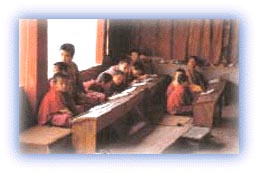Sikkim himalayas
General Info
· Kanchendzonga
· The Teesta Saga
· Zemu Glacier
· Northern Sikkim
Flora and Fauna
· Lanchenpas & Lanchungpas
Religion
Visual Delights

![]()
| People Three tribes -- Naong, Chang and Mon -- are believed to have inhabited Sikkim in prehistoric times. Lepchas, who call themselves "Rong" or "Rong-pa", meaning ravine folk, are believed to be migrants from Assam who came to the region in the 13th century. |
 |
| Education for the young lamas Credit: Discover India |
The Lepchas were followed into Sikkim by the Bhutias, who entered Sikkim primarily from Tibet in the 14th century. While the Bhutias are pastoralists in the high mountains, the Lepchas can be found even in the remotest of valleys. Although intermarriage has occurred between the two groups, they generally live separately and speak their own languages.
The Lepchas are usually monogamous, although a man may have more than one wife. The man may also invite an unmarried younger brother to live with him and share his fields and wife.
 |
| Young Lama Credit: Karamjeet Singh |
The Lepchas were converted to Mahayana Buddhism by the Bhutias. However, they still retain their traditional beliefs, their pantheon of spirits and their shamans who cure illnesses, intercede with the gods, and preside over ceremonies at the time of birth, marriage and death.
The main occupations of the Lepchas are agriculture and cattle breeding. The farmers practise terraced cultivation and grow wheat, barley, rice, buckwheat and corn.
Since the 18th century, the Hindu Nepalese have migrated and settled down in large numbers in Sikkim. Today they constitute about two-thirds of the population of Sikkim. And in present- day Sikkim, Lepchas only number about 25,000 -- roughly 10% of the population.
All rights reserved